Dynamic Evolution and Triggering Mechanisms of the Simutasi Peak Avalanche in the Chinese Tianshan Mountains: A Multi-Source Data Fusion Approach
Abstract
1. Introduction
2. Study Area and Field Investigation
2.1. Study Area
2.2. Field Investigation
3. Materials and Methods
3.1. Data
3.1.1. Meteorological Data
3.1.2. Satellite and UAV Data Sources
3.2. Methods
3.2.1. UAV Image Processing and High-Resolution DEM Generation
3.2.2. Dynamics Modeling
4. Results
4.1. Meteorological and Terrain Factors Governing Avalanche Initiation
4.1.1. Meteorological Factors
4.1.2. Interaction of Meteorological and Terrain Factors
4.2. Remote Sensing-Based Avalanche Identification
4.3. Numerical Simulation by RAMMS::Avalanche Modeling
4.3.1. Analysis of the Simulation Results
4.3.2. Time Series Analysis of Avalanche Flow Height and Field Validation
5. Discussion
5.1. Meteorological and Topographic Controls on Avalanche Release
5.2. Spatiotemporal Characteristics and Recurrence Analysis of Avalanche Paths
6. Conclusions
- (1)
- Based on high-resolution remote sensing imagery and field survey data, the release zone, flow path, and deposition area of the avalanche were accurately identified. The results show that the avalanche path in the study area demonstrates significant spatial stability. The trajectories of previous avalanches closely coincide with that of the current event, indicating a recurrence interval of approximately 2 to 3 years.
- (2)
- The avalanche was triggered by a combination of meteorological and topographical factors. Continuous heavy snowfall, rapid warming, and significant diurnal temperature fluctuations resulted in a marked weakening of the snowpack structure. The stable southeast (SE) wind direction and northwest (NW) lee-slope topography formed a pronounced snow accumulation effect, enhancing the heterogeneity of snow thickness and increasing structural instability. The evolution of meteorological factors and the rapid growth of the snowpack were closely synchronized, indicating that this event was a typical wet snow slab avalanche driven by local meteorological-topographic coupling mechanisms.
- (3)
- The RAMMS model simulation results were highly consistent with the field survey data. The simulated deposition area and flow height were in good agreement with the observed data, with a maximum flow velocity of 19.22 m/s, a maximum flow height of 12.42 m, and a peak dynamic pressure of 129.3 kPa. The simulated deposition zone was in high accordance with historical avalanche traces identified through remote sensing imagery, further validating the spatial recurrence and strong topographical dependence of avalanche paths in this region.
Author Contributions
Funding
Data Availability Statement
Conflicts of Interest
References
- Mayer, S.; Hendrick, M.; Michel, A.; Richter, B.; Schweizer, J.; Wernli, H.; van Herwijnen, A. Impact of Climate Change on Snow Avalanche Activity in the Swiss Alps. Cryosphere 2024, 18, 5495–5517. [Google Scholar] [CrossRef]
- Jamieson, B. Formation of Refrozen Snowpack Layers and Their Role in Slab Avalanche Release. Rev. Geophys. 2006, 44, RG2001. [Google Scholar] [CrossRef]
- Schweizer, J. On Recent Advances in Avalanche Research. Cold Reg. Sci. Technol. 2017, 144, 1–5. [Google Scholar] [CrossRef]
- Schweizer, J.; Bartelt, P.; van Herwijnen, A. Chapter 12—Snow Avalanches. In Snow and Ice-Related Hazards, Risks, and Disasters, 2nd ed.; Haeberli, W., Whiteman, C., Eds.; Hazards and Disasters Series; Elsevier: Amsterdam, The Netherlands, 2021; pp. 377–416. ISBN 978-0-12-817129-5. [Google Scholar]
- Snow Avalanche Formation—Schweizer—2003—Reviews of Geophysics—Wiley Online Library. Available online: https://agupubs.onlinelibrary.wiley.com/doi/full/10.1029/2002RG000123 (accessed on 14 July 2025).
- Timing and Identification of Potential Snow Avalanche Types: A Case Study of the Central Tianshan Mountains|Landslides. Available online: https://link.springer.com/article/10.1007/s10346-021-01766-7 (accessed on 14 July 2025).
- Climate Change Impacts on Snow Avalanche Activity and Related Risks|Nature Reviews Earth & Environment. Available online: https://www.nature.com/articles/s43017-024-00540-2 (accessed on 14 July 2025).
- Christen, M.; Kowalski, J.; Bartelt, P. RAMMS: Numerical Simulation of Dense Snow Avalanches in Three-Dimensional Terrain. Cold Reg. Sci. Technol. 2010, 63, 1–14. [Google Scholar] [CrossRef]
- Eckerstorfer, M.; Malnes, E.; Müller, K. A Complete Snow Avalanche Activity Record from a Norwegian Forecasting Region Using Sentinel-1 Satellite-Radar Data. Cold Reg. Sci. Technol. 2017, 144, 39–51. [Google Scholar] [CrossRef]
- Huo, F.; Guo, F.; Shi, P.; Gao, Z.; Zhao, Y.; Wang, Y.; Meng, X.; Yue, D. The Application of Remote Sensing Technology in Post-Disaster Emergency Investigations of Debris Flows: A Case Study of the Shuimo Catchment in the Bailong River, China. Remote Sens. 2024, 16, 2817. [Google Scholar] [CrossRef]
- Liu, Y.; Chen, X.; Qiu, Y.; Hao, J.; Yang, J.; Li, L. Mapping Snow Avalanche Debris by Object-Based Classification in Mountainous Regions from Sentinel-1 Images and Causative Indices. Catena 2021, 206, 105559. [Google Scholar] [CrossRef]
- Frigo, B.; Bartelt, P.; Chiaia, B.; Chiambretti, I.; Maggioni, M. A Reverse Dynamical Investigation of the Catastrophic Wood-Snow Avalanche of 18 January 2017 at Rigopiano, Gran Sasso National Park, Italy. Int. J. Disaster Risk Sci. 2021, 12, 40–55. [Google Scholar] [CrossRef]
- Eckerstorfer, M.; Malnes, E. Manual Detection of Snow Avalanche Debris Using High-Resolution Radarsat-2 SAR Images. Cold Reg. Sci. Technol. 2015, 120, 205–218. [Google Scholar] [CrossRef]
- Cheng, Q.; Liu, J.; Guo, Q.; Liu, J.; Yang, Z.; Hu, C. Identification and Assessment of Avalanche Hazards in Aerxiangou Section of Duku Expressway in TianShan Mountainous Region Based on Unmanned Aerial Vehicle Photography. Res. Cold Arid Reg. 2025, 17, 145–158. [Google Scholar] [CrossRef]
- Massive Collapse of Two Glaciers in Western Tibet in 2016 After Surge-Like Instability|Nature Geoscience. Available online: https://www.nature.com/articles/s41561-017-0039-7 (accessed on 14 July 2025).
- Maggioni, M.; Gruber, U. The Influence of Topographic Parameters on Avalanche Release Dimension and Frequency. Cold Reg. Sci. Technol. 2003, 37, 407–419. [Google Scholar] [CrossRef]
- Guy, Z.M.; Birkeland, K.W. Relating Complex Terrain to Potential Avalanche Trigger Locations. Cold Reg. Sci. Technol. 2013, 86, 1–13. [Google Scholar] [CrossRef]
- Zhang, T.; Yin, Y.; Li, B.; Liu, X.; Wang, M.; Gao, Y.; Wan, J.; Kaushal, K.R. Characteristics and Dynamic Analysis of the February 2021 Long-Runout Disaster Chain Triggered by Massive Rock and Ice Avalanche at Chamoli, Indian Himalaya. J. Rock Mech. Geotech. Eng. 2023, 15, 296–308. [Google Scholar] [CrossRef]
- Ortner, G.; Bründl, M.; Kropf, C.M.; Röösli, T.; Bühler, Y.; Bresch, D.N. Large-Scale Risk Assessment on Snow Avalanche Hazard in Alpine Regions. Nat. Hazards Earth Syst. Sci. 2023, 23, 2089–2110. [Google Scholar] [CrossRef]
- Hao, J.; Huang, F.; Liu, Y.; Amobichukwu, C.A.; Li, L. Avalanche Activity and Characteristics of Its Triggering Factors in the Western Tianshan Mountains, China. J. Mt. Sci. 2018, 15, 1397–1411. [Google Scholar] [CrossRef]
- Yang, J.; He, Q.; Liu, Y. Winter–Spring Prediction of Snow Avalanche Susceptibility Using Optimisation Multi-Source Heterogeneous Factors in the Western Tianshan Mountains, China. Remote Sens. 2022, 14, 1340. [Google Scholar] [CrossRef]
- Liu, J.; Zhang, T.; Hu, C.; Wang, B.; Yang, Z.; Sun, X.; Yao, S. A Study on Avalanche-Triggering Factors and Activity Characteristics in Aerxiangou, West Tianshan Mountains, China. Atmosphere 2023, 14, 1439. [Google Scholar] [CrossRef]
- Hao, J.; Mind’je, R.; Zhang, X.; Wang, Y.; Zhou, H.; Li, L. Implementation of an Early Warning for Snowfall-Triggered Avalanche to Road Safety in the Tianshan Mountains. Cold Reg. Sci. Technol. 2022, 204, 103675. [Google Scholar] [CrossRef]
- Yanlong, W.; Maohuan, H. An Outline of Avalanches in China. Cold Reg. Sci. Technol. 1986, 13, 11–18. [Google Scholar] [CrossRef]
- McClung, D.; Schaerer, P.A. The Avalanche Handbook; The Mountaineers Books: Seattle, WA, USA, 2006; ISBN 978-0-89886-809-8. [Google Scholar]
- Castebrunet, H.; Eckert, N.; Giraud, G.; Durand, Y.; Morin, S. Projected Changes of Snow Conditions and Avalanche Activity in a Warming Climate: The French Alps over the 2020–2050 and 2070–2100 Periods. Cryosphere 2014, 8, 1673–1697. [Google Scholar] [CrossRef]
- Schweizer, J. Review of Dry Snow Slab Avalanche Release. Cold Reg. Sci. Technol. 1999, 30, 43–57. [Google Scholar] [CrossRef]
- Vionnet, V.; Martin, E.; Masson, V.; Guyomarc’h, G.; Naaim-Bouvet, F.; Prokop, A.; Durand, Y.; Lac, C. Simulation of Wind-Induced Snow Transport and Sublimation in Alpine Terrain Using a Fully Coupled Snowpack/Atmosphere Model. Cryosphere 2014, 8, 395–415. [Google Scholar] [CrossRef]
- Empirical Calculations of Snow–Avalanche Run–out Distance Based on Topographic Parameters|Journal of Glaciology|Cambridge Core. Available online: https://www.cambridge.org/core/journals/journal-of-glaciology/article/empirical-calculations-of-snowavalanche-runout-distance-based-on-topographic-parameters/661F331BA0C1E067BB1C9FAB2106EC8A (accessed on 14 July 2025).
- Full Article: Snow Avalanches in Forested Terrain: Influence of Forest Parameters, Topography, and Avalanche Characteristics on Runout Distance. Available online: https://www.tandfonline.com/doi/full/10.1657/1938-4246-44.4.509 (accessed on 14 July 2025).
- Sharma, S.S.; Ganju, A. Complexities of Avalanche Forecasting in Western Himalaya—An Overview. Cold Reg. Sci. Technol. 2000, 31, 95–102. [Google Scholar] [CrossRef]
- Eckerstorfer, M.; Christiansen, H.H. Relating Meteorological Variables to the Natural Slab Avalanche Regime in High Arctic Svalbard. Cold Reg. Sci. Technol. 2011, 69, 184–193. [Google Scholar] [CrossRef]
- Reardon, B.A.; Pederson, G.T.; Caruso, C.J.; Fagre, D.B. Spatial Reconstructions and Comparisons of Historic Snow Avalanche Frequency and Extent Using Tree Rings in Glacier National Park, Montana, USA. Arct. Antarct. Alp. Res. 2008, 40, 148–160. [Google Scholar] [CrossRef]
- Eckert, N.; Parent, E.; Kies, R.; Baya, H. A Spatio-Temporal Modelling Framework for Assessing the Fluctuations of Avalanche Occurrence Resulting from Climate Change: Application to 60 Years of Data in the Northern French Alps. Clim. Change 2010, 101, 515–553. [Google Scholar] [CrossRef]
- Schweizer, J.; Kronholm, K.; Wiesinger, T. Verification of Regional Snowpack Stability and Avalanche Danger. Cold Reg. Sci. Technol. 2003, 37, 277–288. [Google Scholar] [CrossRef]
- Bühler, Y.; Kumar, S.; Veitinger, J.; Christen, M.; Stoffel, A.; Snehmani. Automated Identification of Potential Snow Avalanche Release Areas Based on Digital Elevation Models. Nat. Hazards Earth Syst. Sci. 2013, 13, 1321–1335. [Google Scholar] [CrossRef]
- Peitzsch, E.H.; Hendrikx, J.; Fagre, D.B.; Reardon, B. Examining Spring Wet Slab and Glide Avalanche Occurrence along the Going-to-the-Sun Road Corridor, Glacier National Park, Montana, USA. Cold Reg. Sci. Technol. 2012, 78, 73–81. [Google Scholar] [CrossRef]
- Denissova, N.; Nurakynov, S.; Petrova, O.; Daumova, G.; Chepashev, D.; Alpysbay, M.; Chettykbayev, R. Dependence of Avalanche Risk on Slope Insolation Level and Albedo. Atmosphere 2025, 16, 556. [Google Scholar] [CrossRef]
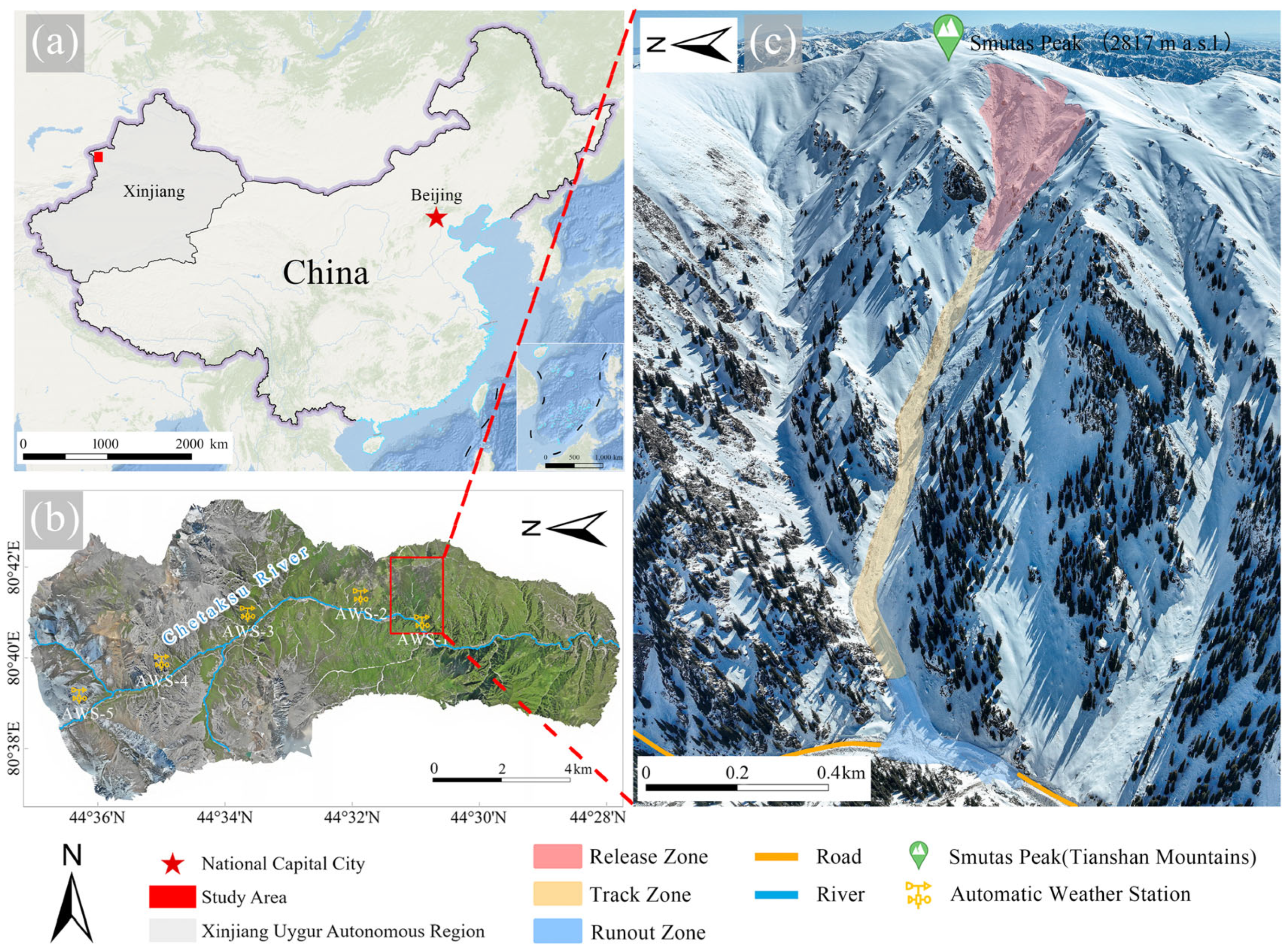
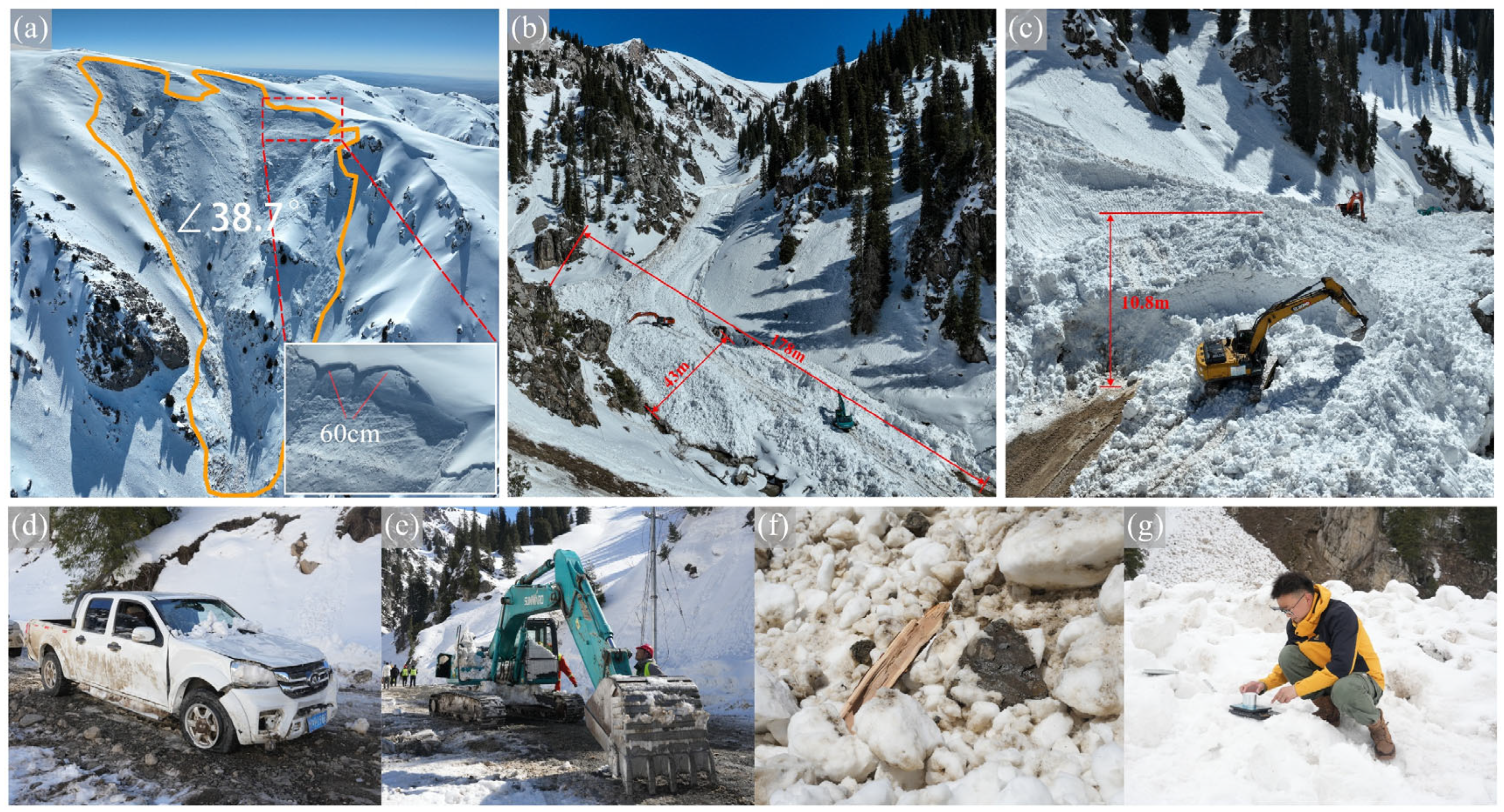
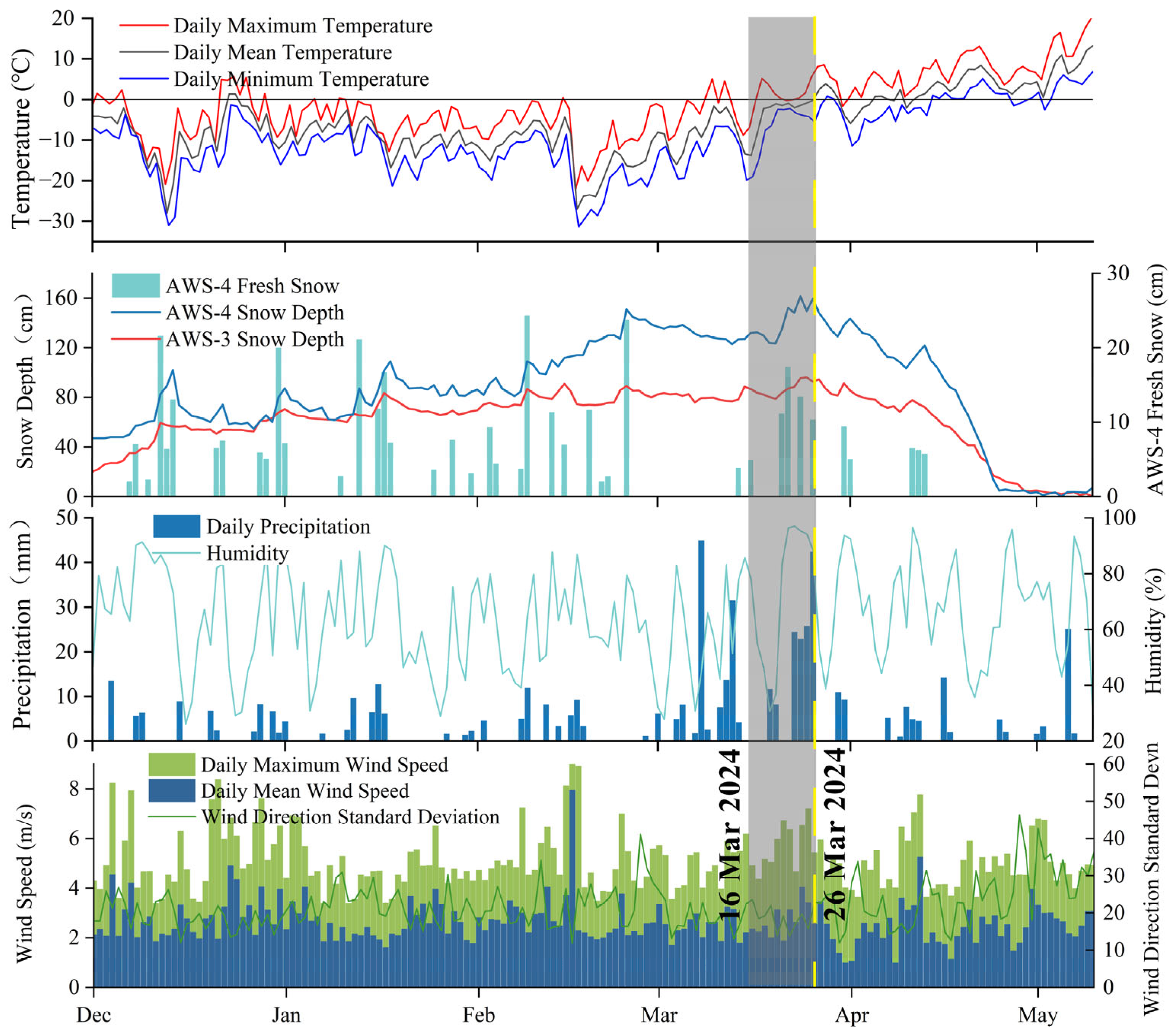
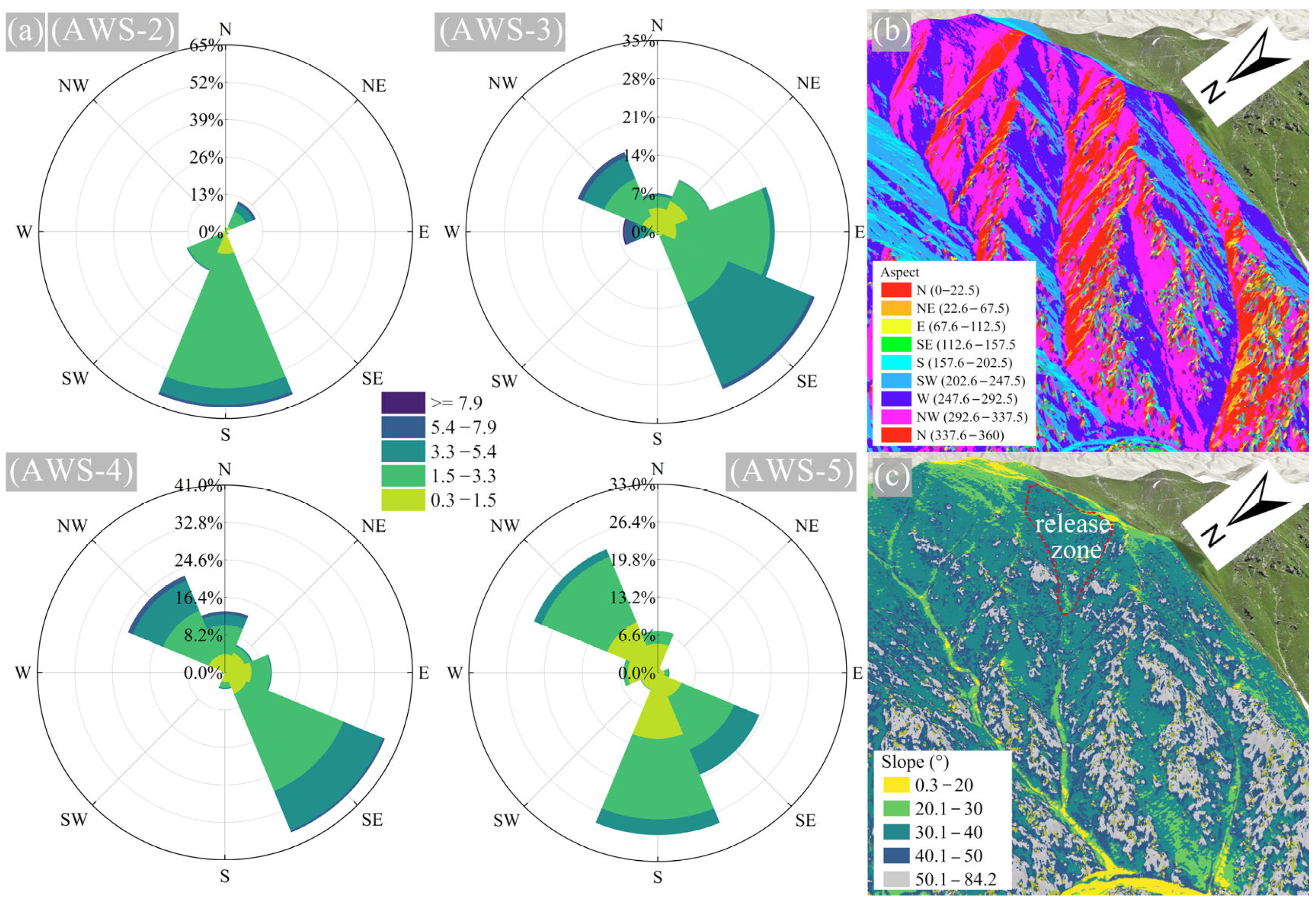
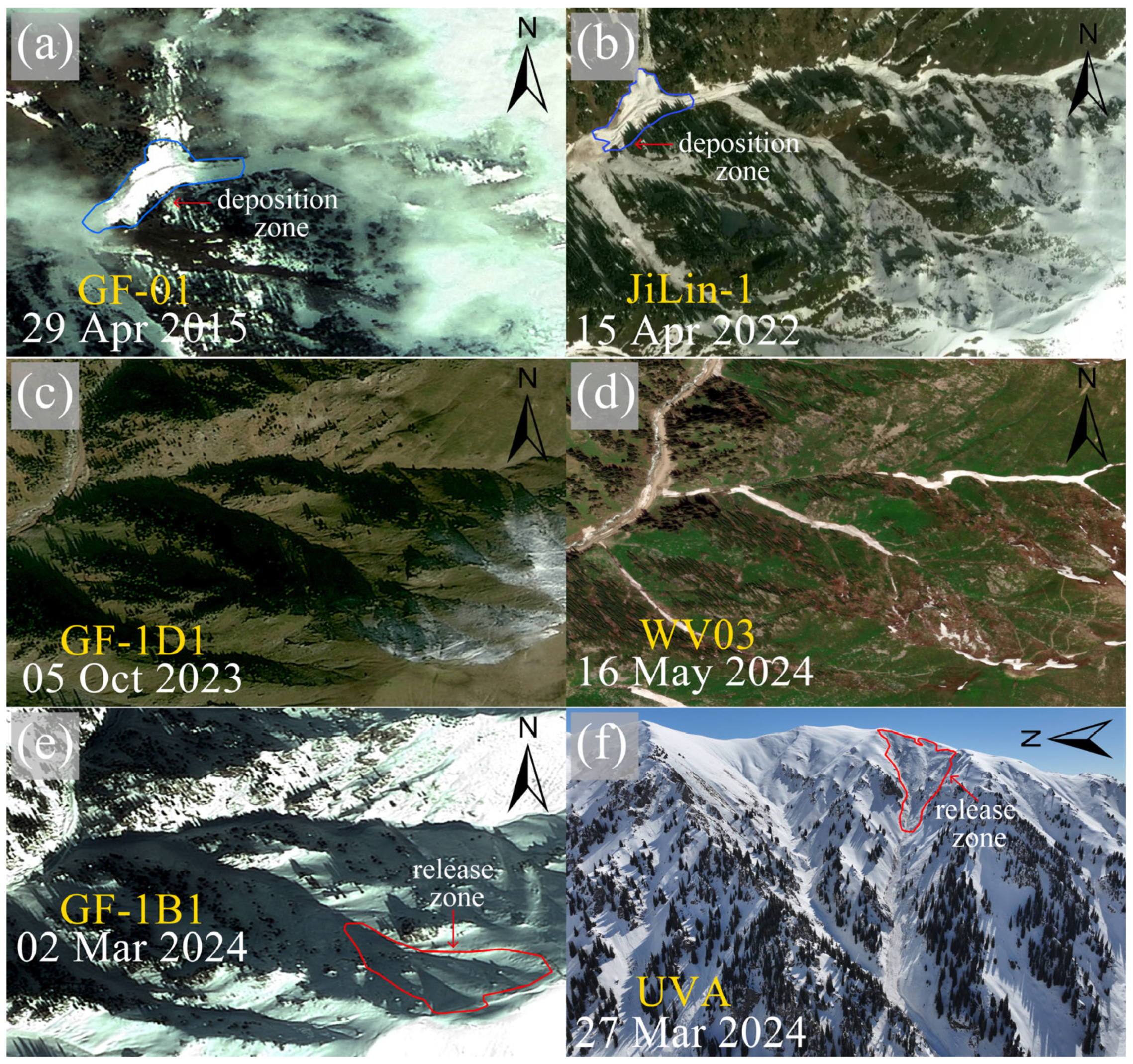

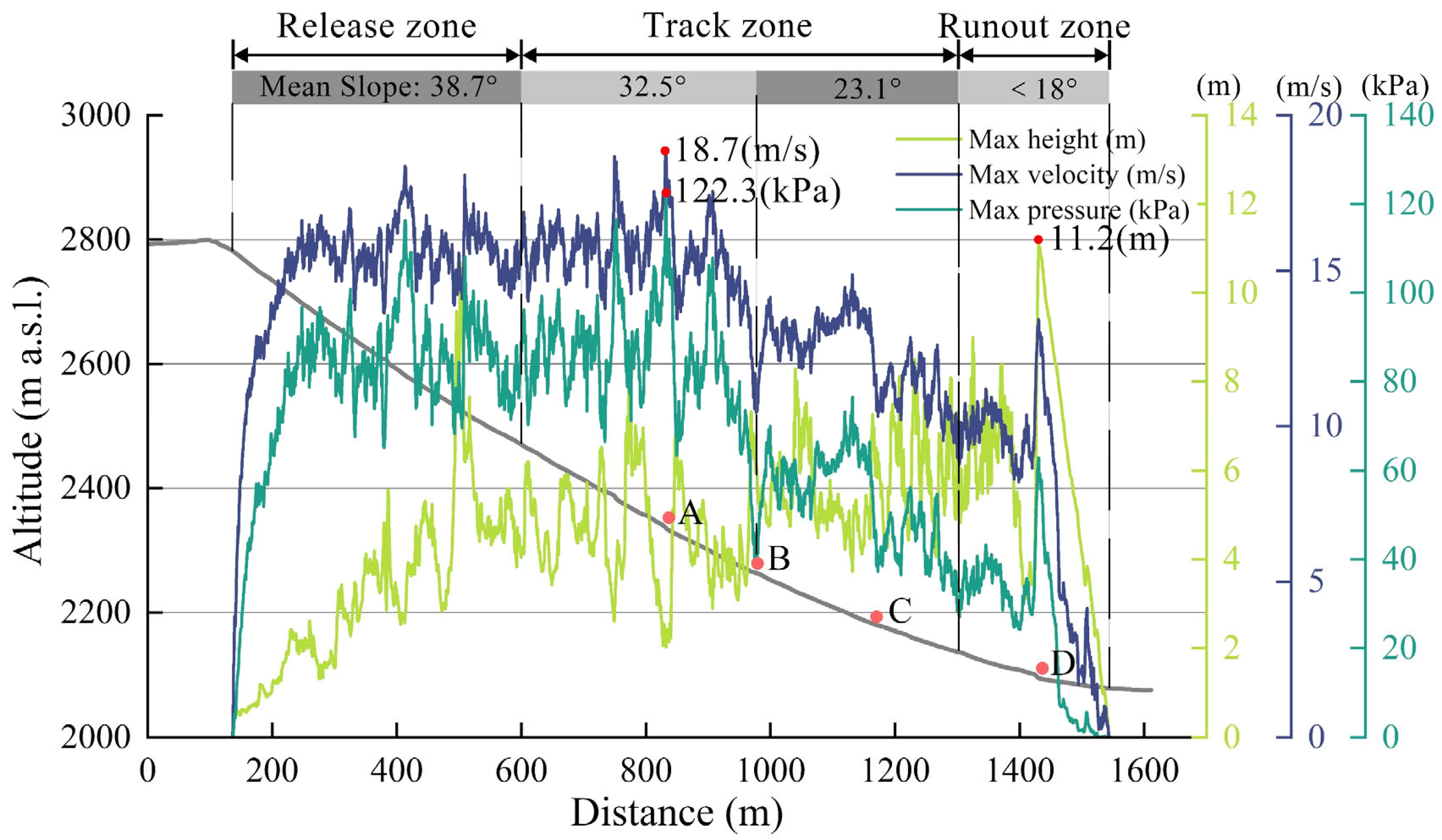
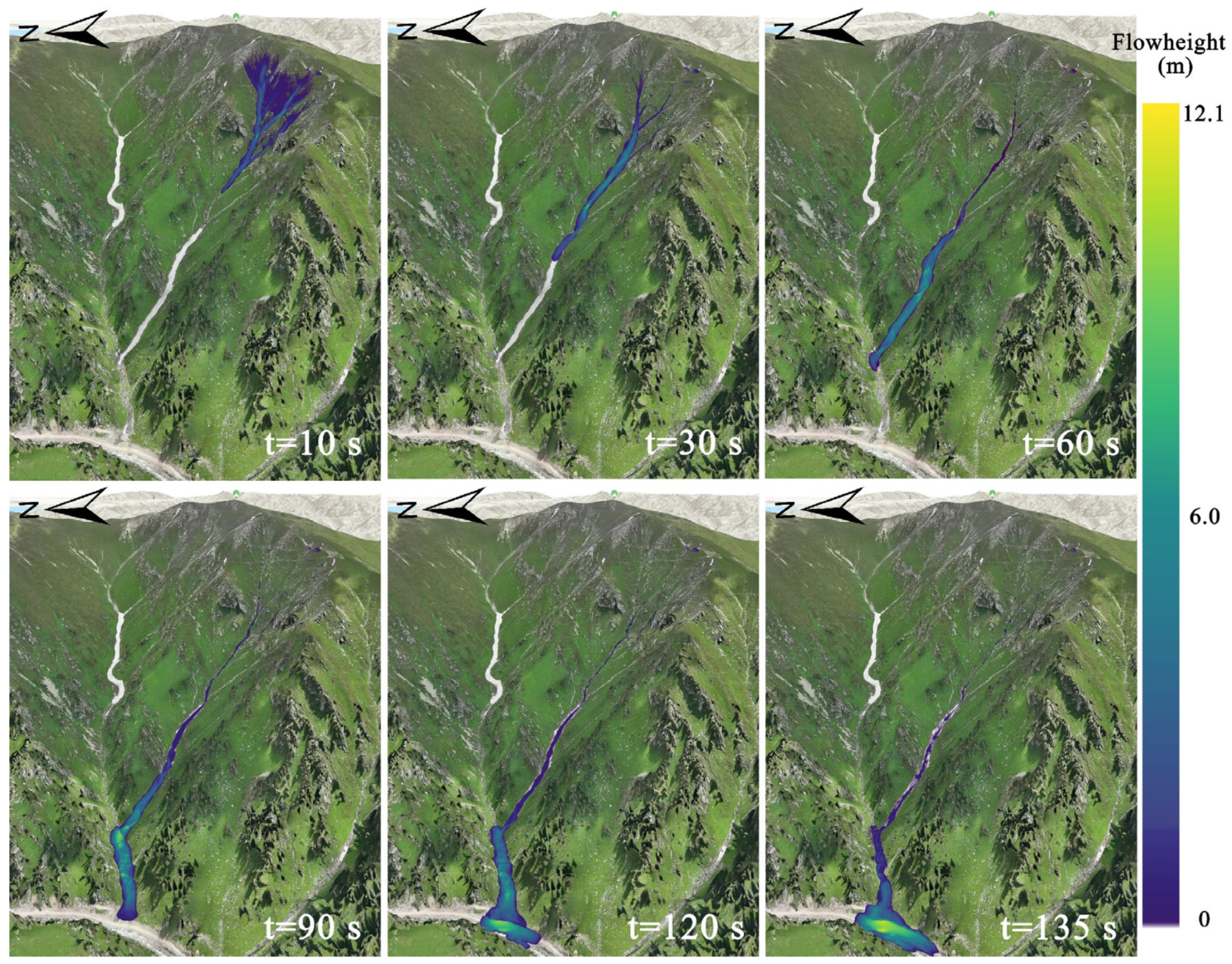
| Station ID | Longitude (°E) | Latitude (°N) | Elevation (m) | Distance to Release (km) | Elevation Difference (m) |
|---|---|---|---|---|---|
| AWS-1 | 80.6752 | 44.5134 | 2014 | 1.7 | −714 |
| AWS-2 | 80.6848 | 44.5315 | 2283 | 2.3 | −445 |
| AWS-3 | 80.6753 | 44.5633 | 2548 | 5.7 | −180 |
| AWS-4 | 80.6588 | 44.5847 | 2739 | 8.7 | +11 |
| AWS-5 | 80.6475 | 44.6055 | 2901 | 12.7 | +173 |
| Satellite | Image Acquisition Date | Spatial Resolution (m) | Data Source and Availability |
|---|---|---|---|
| GF-01 | 29 April 2015 | 2.0 m | Non-open source; Commercial purchase |
| Jilin-1 | 15 April 2022 | 2.0 m | Open-access; Jilin-1 Satellite Data Platform (https://www.jl1mall.com/) |
| CF-1D1 | 5 October 2023 | 2.0 m | Non-open source |
| WV03 | 16 May 2024 | 1.2 m | Open-access; Google Earth |
| CF-1B1 | 2 March 2024 | 2.0 m | Non-open source |
| UAV | 27 March 2024 | 0.1 m | DJI Mavic 3E |
| Parameter Category | Parameter Name | Symbol | Value | Unit |
|---|---|---|---|---|
| Terrain | DEM | — | 0.4 | m |
| Release Zone | Initial snow depth | — | 0.6 | m |
| Snow density | ρ | 350 | kg/m3 | |
| Release volume | — | 60,681.72 | m3 | |
| Friction Model | Dry friction coefficient | μ | 0.28 | — |
| Turbulence coefficient | ξ | 1750 | m/s2 | |
| Cohesion | N0 | 100 | Pa | |
| Simulation | Time step | — | 2 | s |
| Max simulation time | — | 300 | s | |
| Output interval | — | 5 | s |
Disclaimer/Publisher’s Note: The statements, opinions and data contained in all publications are solely those of the individual author(s) and contributor(s) and not of MDPI and/or the editor(s). MDPI and/or the editor(s) disclaim responsibility for any injury to people or property resulting from any ideas, methods, instructions or products referred to in the content. |
© 2025 by the authors. Licensee MDPI, Basel, Switzerland. This article is an open access article distributed under the terms and conditions of the Creative Commons Attribution (CC BY) license (https://creativecommons.org/licenses/by/4.0/).
Share and Cite
Qiang, X.; Huang, J.; Guo, Q.; Yang, Z.; Wang, B.; Liu, J. Dynamic Evolution and Triggering Mechanisms of the Simutasi Peak Avalanche in the Chinese Tianshan Mountains: A Multi-Source Data Fusion Approach. Remote Sens. 2025, 17, 2755. https://doi.org/10.3390/rs17162755
Qiang X, Huang J, Guo Q, Yang Z, Wang B, Liu J. Dynamic Evolution and Triggering Mechanisms of the Simutasi Peak Avalanche in the Chinese Tianshan Mountains: A Multi-Source Data Fusion Approach. Remote Sensing. 2025; 17(16):2755. https://doi.org/10.3390/rs17162755
Chicago/Turabian StyleQiang, Xiaowen, Jichen Huang, Qiang Guo, Zhiwei Yang, Bin Wang, and Jie Liu. 2025. "Dynamic Evolution and Triggering Mechanisms of the Simutasi Peak Avalanche in the Chinese Tianshan Mountains: A Multi-Source Data Fusion Approach" Remote Sensing 17, no. 16: 2755. https://doi.org/10.3390/rs17162755
APA StyleQiang, X., Huang, J., Guo, Q., Yang, Z., Wang, B., & Liu, J. (2025). Dynamic Evolution and Triggering Mechanisms of the Simutasi Peak Avalanche in the Chinese Tianshan Mountains: A Multi-Source Data Fusion Approach. Remote Sensing, 17(16), 2755. https://doi.org/10.3390/rs17162755






